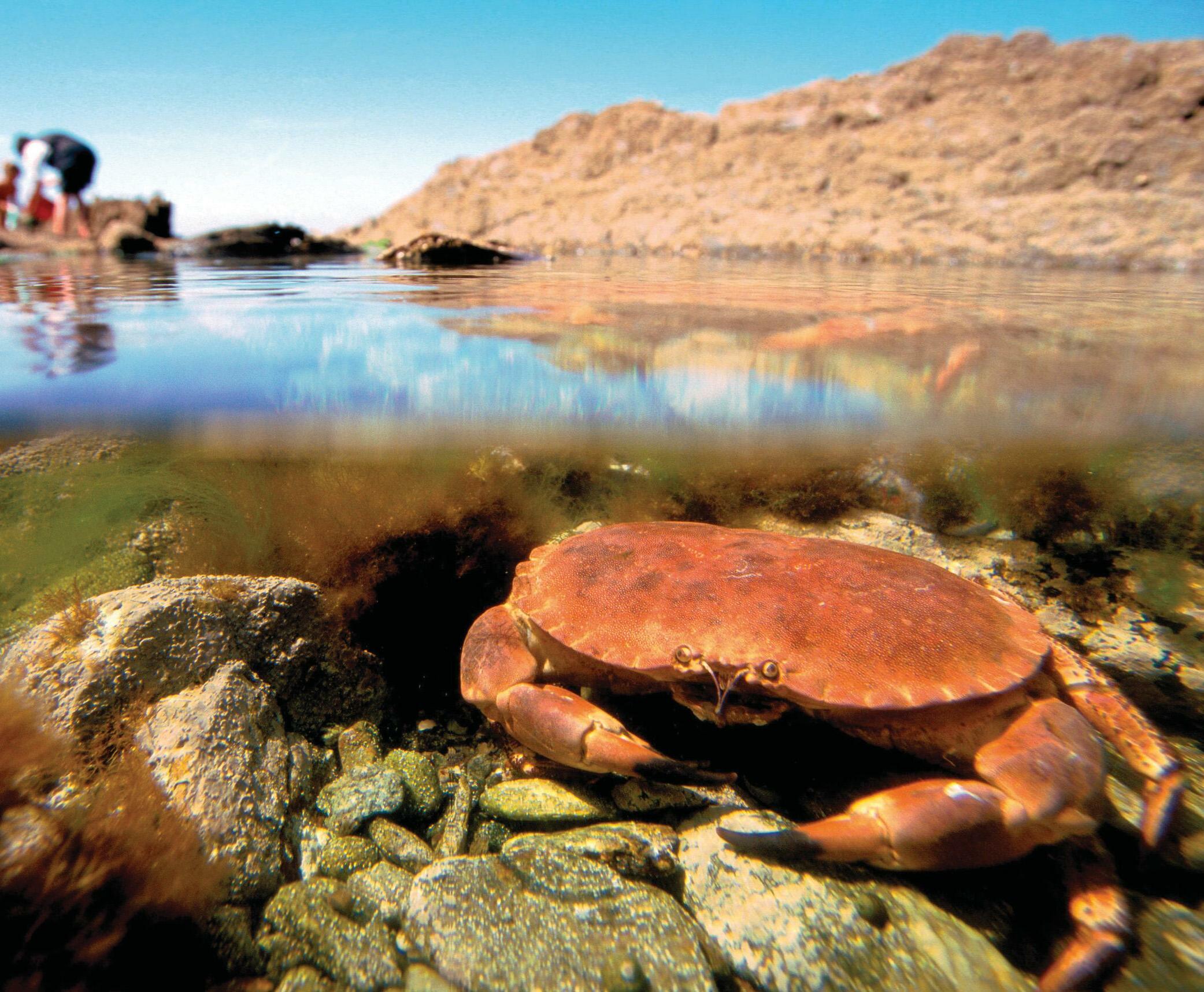
A MEMBER of the cast of The Two Gentlemen of Verona is a dog called Crab. The only canine to appear in a Shakespearean play, Crab is a naughty dog. He steals a chicken and widdles on a lady's dress. His master, Lance, says: 'I think Crab, my dog, be the sourest-natured dog that lives.' It was in Shakespeare's time that bad-tempered people were first described as being crabby.
Real crabs can certainly appear rather grumpy. If you find one of these crustaceans at the beach hunkering in a rockpool, it will likely either scuttle away sideways and hide in some seaweed or stand its ground and brandish a pair of pinching claws at you, hoping you'll be scared enough to leave it alone. Get to know them, however, and there's a lot more to the 60 or so species of crabs that live around the British coast.
Among the most familiar and easily recognisable is the brown crab (Cancer pagurus) also known as the edible crab, with its chunky, oval-shaped shell and that distinctive crimped, pie-crust edge. They're the most important commercial species of crab in Europe, with more than 10,000 tons caught each year in the English Channel. Traps and pots used to catch them take advantage of the fact that, like many crabs, they are not fussy eaters and will feast on anything they find with their highly tuned sense of smell-mussels, clams, other crabs, live prey, dead carrion and the meat or fish scraps fishermen put inside their pots.
Edible crabs follow the trail of wafting scent through the water, climb inside the pots and tuck into the bait; usually, they're still there when the fisherman comes along and hauls the trap back up to the surface.
Edible crabs have a matching pair of stocky, black-tipped claws (technically called chela), which they use to crush their prey. Another common British crab, the shore crab (Carcinus maenas), has a more refined set of claw cutlery: one is sturdy, for smashing, the other slender, for deftly cutting into prey.
This story is from the {{IssueName}} edition of {{MagazineName}}.
Start your 7-day Magzter GOLD free trial to access thousands of curated premium stories, and 9,000+ magazines and newspapers.
Already a subscriber ? Sign In
This story is from the {{IssueName}} edition of {{MagazineName}}.
Start your 7-day Magzter GOLD free trial to access thousands of curated premium stories, and 9,000+ magazines and newspapers.
Already a subscriber? Sign In

Save our family farms
IT Tremains to be seen whether the Government will listen to the more than 20,000 farming people who thronged Whitehall in central London on November 19 to protest against changes to inheritance tax that could destroy countless family farms, but the impact of the good-hearted, sombre crowds was immediate and positive.

A very good dog
THE Spanish Pointer (1766–68) by Stubbs, a landmark painting in that it is the artist’s first depiction of a dog, has only been exhibited once in the 250 years since it was painted.

The great astral sneeze
Aurora Borealis, linked to celestial reindeer, firefoxes and assassinations, is one of Nature's most mesmerising, if fickle displays and has made headlines this year. Harry Pearson finds out why

'What a good boy am I'
We think of them as the stuff of childhood, but nursery rhymes such as Little Jack Horner tell tales of decidedly adult carryings-on, discovers Ian Morton

Forever a chorister
The music-and way of living-of the cabaret performer Kit Hesketh-Harvey was rooted in his upbringing as a cathedral chorister, as his sister, Sarah Sands, discovered after his death

Best of British
In this collection of short (5,000-6,000-word) pen portraits, writes the author, 'I wanted to present a number of \"Great British Commanders\" as individuals; not because I am a devotee of the \"great man, or woman, school of history\", but simply because the task is interesting.' It is, and so are Michael Clarke's choices.

Old habits die hard
Once an antique dealer, always an antique dealer, even well into retirement age, as a crop of interesting sales past and future proves

It takes the biscuit
Biscuit tins, with their whimsical shapes and delightful motifs, spark nostalgic memories of grandmother's sweet tea, but they are a remarkably recent invention. Matthew Dennison pays tribute to the ingenious Victorians who devised them

It's always darkest before the dawn
After witnessing a particularly lacklustre and insipid dawn on a leaden November day, John Lewis-Stempel takes solace in the fleeting appearance of a rare black fox and a kestrel in hot pursuit of a pipistrelle bat

Tarrying in the mulberry shade
On a visit to the Gainsborough Museum in Sudbury, Suffolk, in August, I lost my husband for half an hour and began to get nervous. Fortunately, an attendant had spotted him vanishing under the cloak of the old mulberry tree in the garden.